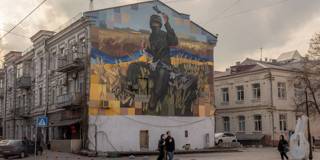Two years after Russia launched its full-scale war of aggression, Ukraine is still holding the line militarily, and even beginning to recover economically. As much as Vladimir Putin wants the world to think he has shielded the Russian economy from blowback, recent financial and economic developments suggest otherwise.
BERKELEY – Two years into its full-scale war of aggression, Russia continues to attack Ukraine’s manufacturing and infrastructure, and Ukraine continues to demonstrate its resilience in the face of a massive military and economic toll. By the end of 2022, Ukraine’s GDP had shrunk by about 30%, and inflation had skyrocketed from 10% to 26.6%. More than ten million Ukrainians had been displaced, and the unemployment rate was as high as 24.5%. The National Bank of Ukraine had devalued its currency from 29 to 36.57 hryvnia to the US dollar.
But since this dark opening chapter, the Ukrainian economy has shown signs of resilience and recovery. In December 2023, the International Monetary Fund found that despite myriad challenges, Ukraine’s macroeconomic indicators were “stronger than expected.” The IMF revised up its 2023 GDP growth projection for Ukraine from 2% to 4.5%, and it expects inflation to fall to 5.5%. With inflation slowing, the National Bank of Ukraine has replaced its fixed exchange rate with a “managed flexible” one. Interest rates have fallen to around 15%, down from 25% at the beginning of 2023.
Meanwhile, Russia’s economy has been showing signs of strain. A report from the US Treasury Department finds that Russia’s economy is 5% smaller than it would have been if President Vladimir Putin had not invaded Ukraine. The same report notes that sanctions have indeed limited the growth of Russia’s economy, leading to high interest rates (16% in December 2023) and a weakening ruble. Between the beginning of 2023 and last October, the exchange rate increased from 69 rubles per dollar to 100 per dollar.

BERKELEY – Two years into its full-scale war of aggression, Russia continues to attack Ukraine’s manufacturing and infrastructure, and Ukraine continues to demonstrate its resilience in the face of a massive military and economic toll. By the end of 2022, Ukraine’s GDP had shrunk by about 30%, and inflation had skyrocketed from 10% to 26.6%. More than ten million Ukrainians had been displaced, and the unemployment rate was as high as 24.5%. The National Bank of Ukraine had devalued its currency from 29 to 36.57 hryvnia to the US dollar.
But since this dark opening chapter, the Ukrainian economy has shown signs of resilience and recovery. In December 2023, the International Monetary Fund found that despite myriad challenges, Ukraine’s macroeconomic indicators were “stronger than expected.” The IMF revised up its 2023 GDP growth projection for Ukraine from 2% to 4.5%, and it expects inflation to fall to 5.5%. With inflation slowing, the National Bank of Ukraine has replaced its fixed exchange rate with a “managed flexible” one. Interest rates have fallen to around 15%, down from 25% at the beginning of 2023.
Meanwhile, Russia’s economy has been showing signs of strain. A report from the US Treasury Department finds that Russia’s economy is 5% smaller than it would have been if President Vladimir Putin had not invaded Ukraine. The same report notes that sanctions have indeed limited the growth of Russia’s economy, leading to high interest rates (16% in December 2023) and a weakening ruble. Between the beginning of 2023 and last October, the exchange rate increased from 69 rubles per dollar to 100 per dollar.